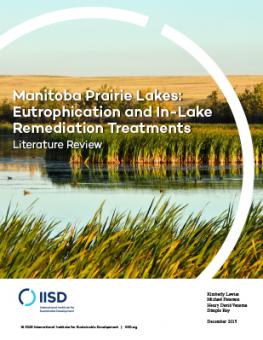
Manitoba Prairie Lakes: Eutrophication and in-lake remediation treatments Literature Review
Eutrophication—the enrichment of ecosystems with chemical nutrients—has deteriorated water quality in many of Manitoba’s lakes.
Eutrophication—the enrichment of ecosystems with chemical nutrients—causes pronounced deterioration of water quality, affecting many of Manitoba’s prairie lakes.
These lakes have deteriorated due to excessive loading of nutrients, organic matter and silt, which in turn cause increased primary producer biomass and reduced water quality. The understanding of eutrophication and its management has evolved from simple control of external nutrient sources to recognition that it is often a cumulative effects issue, requiring protection and restoration of various features of a lake’s community and its catchment.
The success of management techniques varies greatly from lake to lake, where it is generally agreed that these technologies are usually not worth considering unless external nutrient loads can also be reduced and controlled. In-lake remediation techniques can be categorized by limiting and controlling the sediment, or by managing the consequences of lake aging. The techniques described are designed to control nutrients, plankton algae, and other related effects of over-production and species composition changes that result from eutrophication. Algal biomass is dependent on the concentration of the limiting nutrient in the lake’s photic zone; therefore, appropriate evaluation and modelling can determine the feasibility of controlling the primary sources of the most limiting nutrient. More than one technique may be used at once; however, for most in-lake techniques to be effective, important external loading sources should be evaluated and controlled. This review identifies multiple in-lake biological, physical and chemical treatments to limit and control P-enriched sediments and remediate the effects of eutrophication on lake water quality.
Participating experts
You might also be interested in
Manitoba Prairie Lakes: Mass balance budget for nutrient management at Pelican Lake, Manitoba
This study documents the variance and relative importance of different nutrient sources and internal lake processes for a Prairie lake (Pelican Lake, Manitoba).
Manitoba Prairie Lakes: In-lake remediation treatment summary
This is a summary of a comprehensive research study (Manitoba Prairie Lakes: Eutrophication and In-Lake Remediation Treatments Literature Review) in which IISD examines in-lake remediation treatments.
INC-4 Is an Opportunity to Address Fresh Water Pollution – This is how
INC-4 is the fourth meeting in a series of international negotiations that aims to develop a global treaty on plastic pollution that could and should have big implications for freshwater quality both in Canada and beyond.
Northwest Ontario Side Story: IISD Experimental Lakes Area Annual Report 2022-2023
This year's annual report is a celebration of all things creative at the world's freshwater laboratory, from the science to music, photography and theatre.